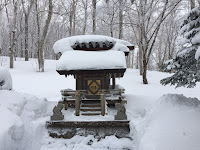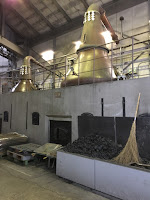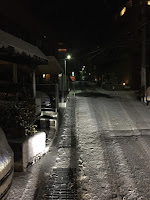A few weekends ago, we headed to Japan's northernmost island of Hokkaido. Hokkaido is known for its volcanoes, natural hot springs, and ski areas. Hokkaido is actually relatively close to Russia (you might actually be able to see Russia from your house) and so the winters are quite harsh with lots of snow and the summers are much cooler and less humid.
 Hokkaido was originally inhabited by Ainu (aborigines of an uncertain ancestry). And, until 1800 the number of Ainu outnumbered the number of Japanese in Hokkaido. Currently, there are about 16,000 Ainu remaining in Hokkaido. In 1868, Japan began major efforts to populate the island in order to strengthen the northern frontier. In the early 1870s, an American agriculturalist was sent to Hokkaido to introduce scientific methods of farming. Farming, and the growth of railroads, helped to populate Hokkaido; however, parts of the island (especially the northern most areas) are still relatively underpopulated.
Hokkaido was originally inhabited by Ainu (aborigines of an uncertain ancestry). And, until 1800 the number of Ainu outnumbered the number of Japanese in Hokkaido. Currently, there are about 16,000 Ainu remaining in Hokkaido. In 1868, Japan began major efforts to populate the island in order to strengthen the northern frontier. In the early 1870s, an American agriculturalist was sent to Hokkaido to introduce scientific methods of farming. Farming, and the growth of railroads, helped to populate Hokkaido; however, parts of the island (especially the northern most areas) are still relatively underpopulated.
Because we only had two full days to explore, we focused this trip's travel on the capital city of Sapporo (and its surrounding areas). Plus, we had chosen this weekend to visit because it coincided with the Sapporo Snow Festival...which was on every "must do" list I'd looked at. So on Friday afternoon, we took a quick two-hour flight (with our friends - the Bauers') and were in Sapporo just in time for dinner!
I am quickly learning that Japan loves food! Okay, I already knew that. However, I've never visited a place in which there is so much pride in local cuisine. Cities and towns LOVE to showcase their cuisine - and give visitors numerous opportunities to sample the yumminess! Hokkaido, as a whole, is famous for ramen, crab, uni and ikura donburi (sea urchin and salmon roe over rice), curry soup, "Genghis Khan," soba noodles, ice cream, melon, and Sapporo beer...of course!
 On Friday night, we set out to fill our tummies with miso ramen. I had read that Sapporo includes corn in their ramen and sometimes puts a pat of butter on top of the noodles as well. You know, the whole cold weather = fattier food concept! Sapporo's "Ramen Alley" has hundreds of little ramen shops...one after another. Visitors simply walk down the alleys and pick a place that looks good to them. We decided rather quickly as we were quite hungry. Although the shop was small and looked a bit grimy (I've learned that this is a sign of an amazing restaurant in Japan) - the ramen and beer was delicious!!
On Friday night, we set out to fill our tummies with miso ramen. I had read that Sapporo includes corn in their ramen and sometimes puts a pat of butter on top of the noodles as well. You know, the whole cold weather = fattier food concept! Sapporo's "Ramen Alley" has hundreds of little ramen shops...one after another. Visitors simply walk down the alleys and pick a place that looks good to them. We decided rather quickly as we were quite hungry. Although the shop was small and looked a bit grimy (I've learned that this is a sign of an amazing restaurant in Japan) - the ramen and beer was delicious!!  On Saturday morning, we headed downtown to explore the snow festival. The Sapporo Snow Festival began in 1950, when local middle and high school students exhibited six snow sculptures at Odori Park. Today, it has become one of the most popular winter-time activities in Japan and attracts over two million visitors every year. The snow festival has three main areas: Odori Park, which featured the snow sculptures and an insane amount of food vendors; Susukino, which featured the ice sculptures; and Tsudome, which featured lots of "fun in the snow" activities.
On Saturday morning, we headed downtown to explore the snow festival. The Sapporo Snow Festival began in 1950, when local middle and high school students exhibited six snow sculptures at Odori Park. Today, it has become one of the most popular winter-time activities in Japan and attracts over two million visitors every year. The snow festival has three main areas: Odori Park, which featured the snow sculptures and an insane amount of food vendors; Susukino, which featured the ice sculptures; and Tsudome, which featured lots of "fun in the snow" activities.  I could not believe how HUGE the snow sculptures were. In one of the pictures below, you can see a person standing on the stage...which should give you a better understanding of the enormity of these sculptures. In addition to the main sculptures, there were some smaller ones as well. It seemed like this year's "theme" was the "Pineapple Apple Pen" man - as there were so many sculptures of him. He's a Japanese sensation - no clue why! Look him up on YouTube if you have no idea what I am talking about! Each night, the main sculptures were lit up with lights...and some even had choreographed light shows.
I could not believe how HUGE the snow sculptures were. In one of the pictures below, you can see a person standing on the stage...which should give you a better understanding of the enormity of these sculptures. In addition to the main sculptures, there were some smaller ones as well. It seemed like this year's "theme" was the "Pineapple Apple Pen" man - as there were so many sculptures of him. He's a Japanese sensation - no clue why! Look him up on YouTube if you have no idea what I am talking about! Each night, the main sculptures were lit up with lights...and some even had choreographed light shows. And, here's just a few pics of the food vendors! Kaz was thrilled to enjoy his uni and ikura donburi...I went for the grilled corn (which was of course served in a bag to lessen the chance of making a huge mess!).
After a few hours at the snow festival (which is all I think you need, if you are thinking of visiting in the future), we headed over to the Tsudome to check out the snow activities. I'll have to admit that it was quite underwhelming...however, we did take a ride on a raft pulled by a snowmobile and slide down an ice slide most likely designed only for kids. I actually got stuck and had to push myself most of the way down!
We ended our action-packed day at the Sapporo Beer Museum, which is interestingly the only beer museum in Japan. Guided tours are unfortunately offered only in Japanese; however, the exhibits come with written English translations. And, after you spend time wandering around...you can enjoy snacks and tastings in the warm and cozy tasting room!

The next morning, Kaz and I took a 45-minute train ride to Otaru. Otaru is a small town that served as a major trade and fishing port in the late 1800s. A canal runs through the center of the town and is lined with warehouses (which have been converted into shops and restaurants).
We had read about a cable car that takes visitors to the top of Mt. Tengu...and provides a wonderful view of the bay. So, we thought we'd give it a try. The cable car was actually a ski lift at a rather small ski resort; however, there was lots of snow at the top (which helped me to really feel like I was in Hokkaido) and we even stumbled across a ski museum. I learned that Otaru is actually credited as the "origin of skiing in Japan."
 After our "mountain adventure," we strolled along the canal. It's funny, in Otaru especially, I really didn't feel like I was in Japan. There was a ton of snow and very few people...it almost felt like a small "up north" Michigan town. Until...several people dressed like anime characters walked past us...and I was reminded that I was indeed in Japan! As we explored Otaru's main street, we stumbled upon The Otaru Beer Company, which is actually a small brewery that makes you feel like you are in Germany. I haven't been to Germany, but the decor looks German, the staff was dressed in lederhosen, and they served German food. We learned that a business man from Otaru went to Germany specifically looking for a brewer to come back to Otaru and open a brewery! He was successful and there are currently two Germans in this small town!
After our "mountain adventure," we strolled along the canal. It's funny, in Otaru especially, I really didn't feel like I was in Japan. There was a ton of snow and very few people...it almost felt like a small "up north" Michigan town. Until...several people dressed like anime characters walked past us...and I was reminded that I was indeed in Japan! As we explored Otaru's main street, we stumbled upon The Otaru Beer Company, which is actually a small brewery that makes you feel like you are in Germany. I haven't been to Germany, but the decor looks German, the staff was dressed in lederhosen, and they served German food. We learned that a business man from Otaru went to Germany specifically looking for a brewer to come back to Otaru and open a brewery! He was successful and there are currently two Germans in this small town!  The last stop on our Hokkaido tour was to visit the Nikka Whisky Distillery in Yoichi (about a 40-minute bus ride from Otaru). Nikka Whisky is one of the most popular whiskies in Japan. Masataka Taketsuru - the founder and the "Father of Japanese Whisky" - learned the art of whisky in Scotland. Interestingly, he met his wife there - and she moved back to Japan with him. He even designed their house to look more Western, so that his wife felt more at home in Japan. We took a short tour of the distillery - the grounds were absolutely beautiful - and then enjoyed some tastings. I am not a whisky fan, but I did really enjoy their apple wine! :)
The last stop on our Hokkaido tour was to visit the Nikka Whisky Distillery in Yoichi (about a 40-minute bus ride from Otaru). Nikka Whisky is one of the most popular whiskies in Japan. Masataka Taketsuru - the founder and the "Father of Japanese Whisky" - learned the art of whisky in Scotland. Interestingly, he met his wife there - and she moved back to Japan with him. He even designed their house to look more Western, so that his wife felt more at home in Japan. We took a short tour of the distillery - the grounds were absolutely beautiful - and then enjoyed some tastings. I am not a whisky fan, but I did really enjoy their apple wine! :)
After the distillery, we headed back to Sapporo to finish up our trip with some more food - and impromptu sledding! I really enjoyed the little bit of Hokkaido that we were able to explore this weekend. I really hope that we'll be able to squeeze in another trip to Hokkaido before we leave Japan - so that we'll be able to explore some of the "untouched" areas!












































